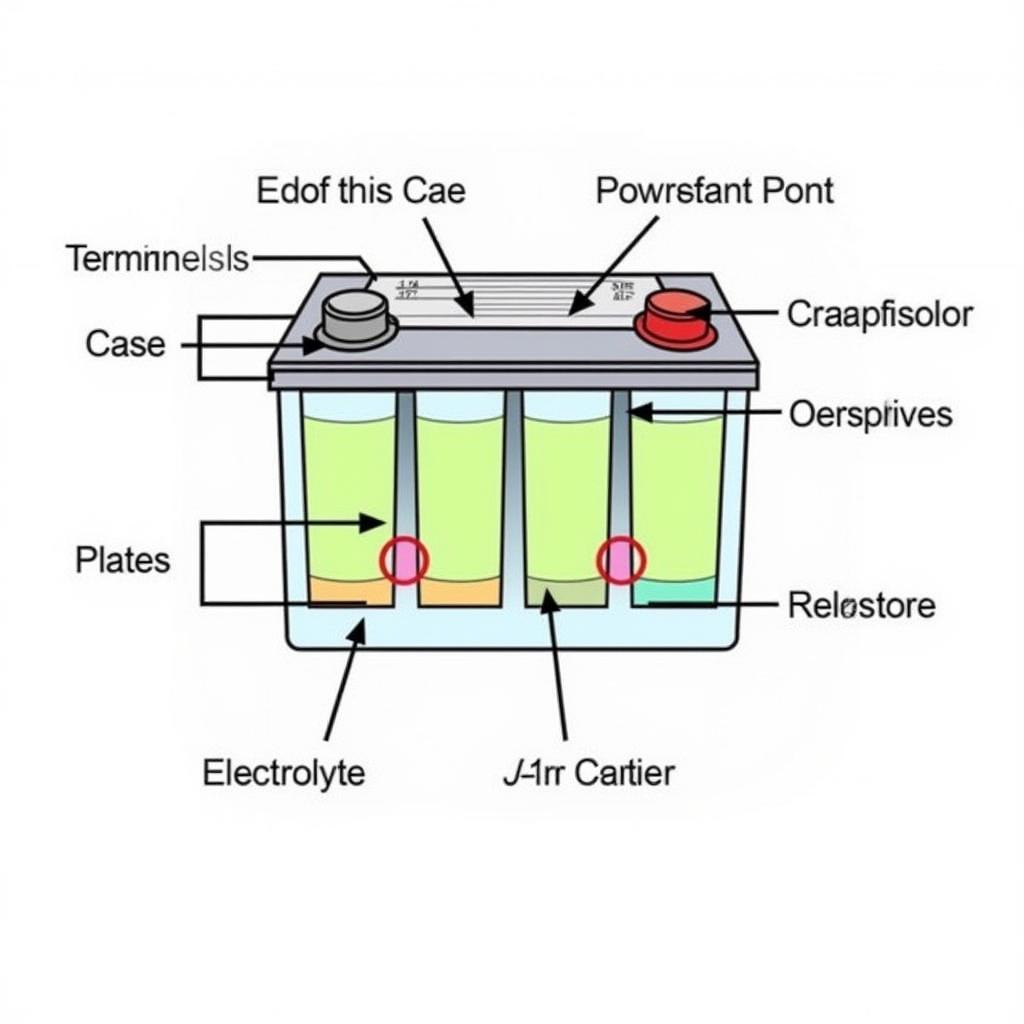Understanding Car Battery Parts Details is crucial for maintaining your vehicle’s electrical system and ensuring reliable starts. A dead battery can leave you stranded, so knowing the components and their function can help you troubleshoot problems and make informed decisions about maintenance and replacement. Let’s dive into the inner workings of your car battery.
Decoding the Core Components of a Car Battery
A car battery isn’t just a box of power; it’s a sophisticated piece of engineering. Several key components work together to provide the electrical energy your car needs. These include:
- Terminals: These are the positive (+) and negative (-) connection points on the battery. They provide the pathway for electrical current to flow in and out of the battery. Cleaning your battery terminals is a simple maintenance task that can prevent corrosion and ensure a good connection.
- Case: The sturdy outer casing protects the internal components from damage and spills. It’s typically made of hard plastic and is designed to withstand the harsh conditions under the hood.
- Cells: These are the individual compartments within the battery that store the electrical energy. Each cell produces approximately 2.1 volts, and a typical car battery has six cells connected in series to produce a total of 12.6 volts.
- Plates: Submerged within each cell are positive and negative plates made of lead and lead dioxide. These plates are immersed in an electrolyte solution and are essential for the chemical reaction that produces electricity.
- Electrolyte: This is a solution of sulfuric acid and water that facilitates the chemical reaction between the plates. The electrolyte level should be checked regularly and topped off with distilled water if necessary.
- Separators: Thin, porous sheets of material placed between the positive and negative plates to prevent them from touching and short-circuiting the battery.
After discussing the internal components, let’s explore the different types of batteries available. Understanding your options is crucial for choosing the right battery for your specific vehicle and driving habits. Looking for a reliable car service? Check out our car service details.
Different Types of Car Batteries: Exploring Your Options
There are several types of car batteries, each with its own advantages and disadvantages. Some of the most common types include:
- Lead-Acid Batteries (Conventional): The most common and affordable type. They require regular maintenance, including checking the electrolyte level.
- Maintenance-Free Batteries (Sealed): These batteries are sealed and require no maintenance. They are a good choice for drivers who prefer a hands-off approach.
- AGM (Absorbent Glass Mat) Batteries: These batteries are designed for high-performance vehicles and offer superior starting power and vibration resistance.
- Gel Cell Batteries: These batteries are known for their deep-cycle capabilities and are often used in marine and RV applications.
 Car Battery Parts Diagram
Car Battery Parts Diagram
Choosing the right battery can be complex. You can find complete details about car specifications on our site: full details of a car.
How Does a Car Battery Work? The Science Behind the Start
The process of generating electricity in a car battery involves a chemical reaction between the lead plates and the electrolyte solution. When you turn the ignition key, the battery discharges a burst of electrical energy to start the engine. The alternator then takes over and recharges the battery while the engine is running.
- Discharging: When the battery discharges, the lead and lead dioxide plates react with the sulfuric acid in the electrolyte, producing lead sulfate and water. This chemical reaction releases electrons, which flow through the circuit to power the starter motor and other electrical components.
- Recharging: When the alternator recharges the battery, the process is reversed. The lead sulfate is converted back into lead and lead dioxide, and the water is recombined with the sulfuric acid. This process stores electrical energy in the battery for future use.
Troubleshooting Common Car Battery Issues
Understanding car battery parts details empowers you to troubleshoot common problems:
- Slow Cranking: This could indicate a low battery charge, corroded terminals, or a failing starter motor.
- Dim Headlights: Dim headlights, especially when the engine is idling, can be a sign of a weak battery.
- Clicking Sound When Turning the Key: This usually indicates a dead battery or a poor connection between the battery terminals and the cables.
For expert car service advice, you can explore contact details on our website: bosch car service contact details.
Extending the Life of Your Car Battery: Tips and Tricks
Here are some practical tips to help prolong the life of your car battery:
- Clean the Terminals Regularly: Remove any corrosion with a baking soda and water solution.
- Avoid Short Trips: Short trips don’t give the alternator enough time to fully recharge the battery.
- Turn Off Accessories When the Engine is Off: Leaving lights or the radio on can drain the battery.
- Test Your Battery Regularly: A simple battery test can help identify potential problems before they leave you stranded.
Conclusion: Powering Your Knowledge of Car Battery Parts
Understanding car battery parts details is essential for every car owner. By familiarizing yourself with the components, their functions, and proper maintenance procedures, you can ensure your car starts reliably every time and avoid unexpected breakdowns. Regular maintenance and timely replacements will keep your car powered up and ready for the road.
FAQ
- How often should I replace my car battery?
- What are the signs of a failing car battery?
- Can I jump start my car with a dead battery?
- How do I choose the right battery for my car?
- What should I do if my car battery is leaking?
- How can I dispose of my old car battery properly?
- What causes car battery corrosion?
Need assistance? Contact us via WhatsApp: +1(641)206-8880 or Email: [email protected]. Our customer service team is available 24/7.

Leave a Reply